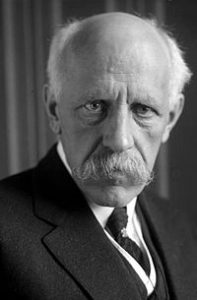Nansen passport a utopian solution to displacement
An historic, though little known, solution to the response to the global displacement crisis and the arrival of hundreds of thousands of migrants in Europe and other places may have been overlooked, according to a European academic.
University of Bremen social scientist Stefan Wallaschek says the reintroduction of the ‘Nansen passport’ could help in the processing of streams people fleeing conflict and war.
The Nansen passport, created shortly after the Russian civil war in 1922, was an international certificate issued as a substitute for a national passport which allowed for the transit of stateless refugees.

Fridtjof Nansen
Mr Wallaschek says it could do so again.
The brainchild of the passport was Norwegian diplomat Fridtjof Nansen, who was High Commissioner for Refugees at the League of Nations, the passport went on to be recognised by 52 countries and help nearly half a million refugees.
The initiative, the first legal instrument for the protection of refugees, won Nansen the Nobel Peace Prize.
“Amid today’s confusion surrounding national asylum systems and controversies over the status of ‘safe countries of origin’, the revival of the Nansen passport in a modern form is overdue,” writes Mr Wallaschek, a PhD student.
“It could be the cornerstone of a common European migration and refugee policy, something European leaders have preferred to talk about rather than enact,” he said.
Mr Wallaschek says the Treaty of Lisbon, the constitutional basis of the European Union, envisages a value-driven community in which there is a spirit of solidarity.
But, in contrast, the Dublin Convention, which oversees asylum applications, is not a burden-sharing mechanism – it obliges the first country that asylum seekers enter to deal with them.
“The Nansen passport would solve this contradiction by relieving the pressure on frontier states such as Greece, Malta and Italy,” Mr Wallaschek says.
“The passport could be distributed by EU officials to asylum seekers in UNHCR refugee camps. A potential pilot program might involve Syrians who usually get refugee status in any case, but normally have to risk crossing the Mediterranean to obtain it.
“For refugees it would provide an EU-wide ID card, valid for two to three years at first and then offering the freedom to enter any EU member state.
If necessary, this could be combined with a mandatory relocation plan throughout the EU to relieve the burden on countries receiving disproportionately high numbers of refugees,” he said.
Mr Wallaschek said that while regular refugee travel documents are only given to those who have already been registered in a host country, the Nansen passport would provide the displaced people with freedom of movement in Europe – or anywhere else right away.
Writing in the journal News Deeply, Mr Wallaschek expressed doubt his idea would get off the ground in the current political climate but he said it was obvious new thinking was needed on the issue of displacement.
“Current political circumstances are clearly not favourable to radical solutions such as the Nansen passport. However, if we think only about what is possible we will lose sight of the need to decide what should really be done,” he said.
“The revival of this old idea is realistically utopian and could elevate current political debates and policies. It is realistic enough to work, given a chance, and utopian in the sense of restoring some justice to future migration policy,” Mr Wallaschek said.
Laurie Nowell
AMES Australia Senior Journalist












